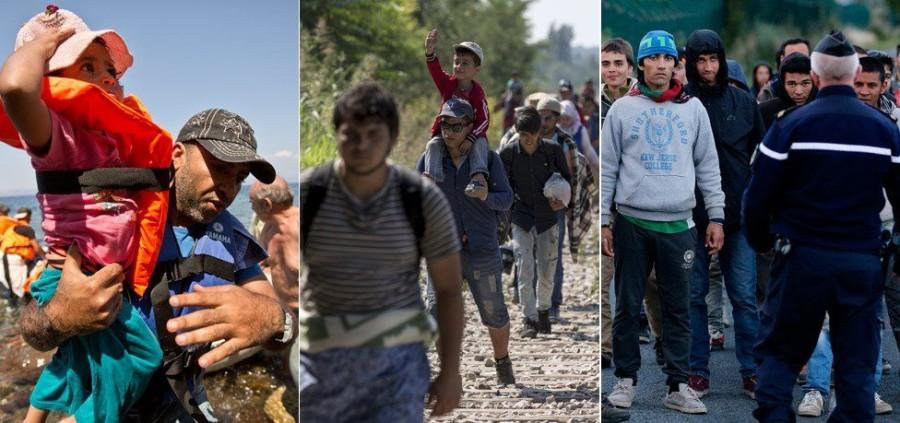The Great Migration into Europe
November 17, 2015
THE GREAT MIGRATION INTO EUROPE
Why are people going to Europe?
As mentioned in a report published by MercyCorps.org, Syrian men, women, and children are fleeing Syria in astonishing numbers — an estimated four million refugees — to try and escape the civil war-torn Syria.
During the Arab Spring, Syrians first resisted peacefully, then joined together to create the Free Syrian Army to fight against President Bashar al-Assad’s established regime. The war was exacerbated when the radical Islamic terrorist group, ISIS, entered the fray. Additionally, there is now an added political complexity associated with the arrival of help from international powers like the United States and Russia.
With more than 220,000 people killed, including civilians, it has become a necessity for a large-scale migration out of the now dangerous Syria. It is now a matter of assisting with what some have called “the worst humanitarian disaster of our time.”
How?
Everyday thousands of refugees are fleeing. But how do they cross the Mediterranean? Many use small boats and rafts that are horrendously overcrowded. Some cruise ships have been used to transport a larger amount of refugees. In addition, many men and women have resorted to walking on foot — traveling astounding distances.
How is Europe responding?
So far Europe has yet to find an effective way to distribute and care for the people coming in. Most of the burden falls on the countries who border the Mediterranean like Greece and Italy. While a resettlement plan by the European Union has been made, distributing 120,000 refugees (54,000 from Hungary, 50,400 from Greece and 15,600 from Italy) over two years. But this only lightens the burden for those countries in the slightest way. Ineffective solutions to the problem have lead to a lot of tension within the European Union, as the distribution of immigrants does not factor in a country’s wealth, population, and overall ability to accept a certain number of people. Hungary— for example— with a population of 10 million and a GDP of 137 billion USD in 2014, is hosting about 100,000 refugees. France, which has a population 65 million people and a GDP of 2.8 trillion USD in 2014, is only hosting about 25,000 refugees. The difference puts a lot more pressure on a country that can’t necessarily handle it. While there are plans presented in the European parliament like the one mentioned above, these are often not enough to deal with the problem completely.
Another problem is the response of certain politicians and the native people of certain countries. Many European leaders are responding in actively hostile ways. Denmark has placed ads in Lebanese newspapers (Lebanon is hosting a lot of Syrian refugees) that threaten various harsh consequences if refugees come to Denmark. The only country who isn’t actively hostile is Germany, which has become a primary destination for many refugees. Germany is hosting about 250,000 refugees, the highest among all the Europeans countries.
Why are so many countries responding in a hostile way to these refugees? The main source is the right-wing politics, which was on the rise in Europe long before this crisis started. The rhetoric these politicians, who often hold powerful positions, use depicts the refugees often as freeloaders who come to take advantage of all the social benefits that most European countries provide. This assumption is dangerous and incorrect.
What we can do to help
Note: This sidebar is written as an increasingly satirical piece, somewhat along the line of Jonathan Swift’s “A Modest Proposal”
The U.S. is currently going to take 10,000 people displaced Syrian refugees from the European migrant crisis. In PCS terms, that’s more the 16 times the population of PCS moving across the Atlantic ocean. If each person weighs 150 pounds and the Transatlantic shipping rate is $100 a ton, it would cost $75,000 to move everyone to America. In case you were wondering, I made these terms arbitrarily.
That’s not super expensive. However, the refugees would want better treatment than being stuffed into a shipping container and being dumped out a week later in America. That would violate basic human rights.
Every single country in Europe has been complaining about the influx of migrants, so I decided to explore how we, the U.S., could cope with the massive influx of 10,000 people economically. (From here on out, this sidebar is a satirical piece–I’m joking.)
To fund my $75,000 “Relief” Plan, I have a variety of options. I could levy a tax to each American citizen of a whopping 0.025 cents.
7,500,000 cents / 300,000,000 people in US population = 0.025 cents/person
Since this is literally unpayable, and would round down to zero, I could instead make 7.5 million randomly chosen American citizens pay one cent.
$75,000 * 100 cents = 7,500,000 cents, so 1 cent per person at 7.5 million people
If I were extremely evil, I could make the 500 or so people at PCS pay $150 each.
$75,000 / 500 people = $150/person
If I hated PC’s like some Mac users do, I could take all $75,000 from the richest person in the world today: Bill Gates. According to Forbes magazine, he has 80 billion dollars ($80,000,000,000), so I would be taking a mighty 0.000001% of his current wealth, rounding my percentage up.
$75,000 / $80,000,000,000 = 0.0000009375%, rounded to 0.000001
At that rate, Bill Gates alone could ship over 9,000,000,000 people, which is bigger than the current population of the entire world, and still 10 billion dollars left over.
$70,000,000,000 / $7.5 per person = 9,333,333,333.3333333333333333333 people
However, before you begin campaigning for the Vu Migrant Relief Plan, consider that migrants would want better treatment than being stuffed into a shipping container and being dumped out a week later in America. That would probably violate basic human rights, as well as their right to life. They would arrive in America as cadavers.
If you were more mercenary and were looking just to make money, you could ship the migrants over in the cargo class, and then if (when) they happen to die, you could sell their body. According to DataGenetics, a human body, when broken into pure elements, is worth about $160. At $7.50 per person to bring him/her/it here, that’s over 20 times the amount of money we started with, including the initial “cost” of the migrants.
$160 / $7.5 = 21.333333333333333333333333333333333333333333333 times original cost
If all of the migrants unfortunately happened to die, we would have 1.6 million dollars.
If you want even more money, consider this: according to GizModo, a single kidney costs over $250,000 in the U.S. which means that, again, if, for some unfortunate reason, all 10,000 migrants died, we would have over 5 billion dollars, just from kidneys.
10,000 people * 2 kidneys per person (they’re dead already) * $250,000 per kidney = $5 billion
Bill Gates is still scoffing at us.
An uncited note in the DataGenetics article states that the human body can be worth up to 45 million dollars. If this is true, then our migrant graveyard would be worth $450,000,000,000, or 450 billion dollars. You can do the math for this number.
The richest person in modern history, Richard Meyers Rothschild, coincidentally had about the same amount of money: 450 billion dollars (after converting to 2015 USD).
A practical solution: bring migrants here as passengers (not cargo), employ them or enroll them in an occupational school, and have them pay off their own passage fee.


